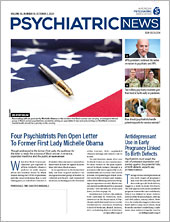The world continues to grapple with the COVID-19 pandemic, and another crisis seethes below the surface: As people have found themselves restricted to their homes due to widespread stay-at-home orders, reports of domestic violence have increased globally.
A study published in the April American Journal of Emergency Medicine noted that reports of domestic violence increased in China, France, Argentina, Cyprus, and Singapore in the wake of the pandemic. Anecdotally, the United States has also seen an increase in reports, including in Portland, San Antonio, New York City, and Jefferson County, Alabama.
For psychiatrists who are largely seeing their patients through telehealth, a new uncertainty has arisen: How do they help patients who may be experiencing violence at home?
“Everything bad is made worse during the pandemic, and domestic violence certainly isn’t an exception,” said Louisa Olushoga, M.D., a reproductive psychiatrist at the Northwestern University Feinberg School of Medicine. She works predominantly with women, particularly those who have experienced trauma, including human trafficking. “Not only have these victims been locked in close quarters with perpetrators for extended times, there are the additional stressors of financial concerns, anxiety, depression, and frustration, which of course breed substance use,” Olushoga said. “It’s not only the factor of proximity; there are all these other triggers that exacerbate a bad situation.”
Victims of Domestic Violence Often Have Few Resources
Obianuju Berry, M.D., is an assistant professor in the Department of Child and Adolescent Psychiatry at NYU Langone and Medical Director of NYC Health + Hospitals Family Justice Center Mental Health Collaboration in New York City. Her team provides psychiatric services to people who have experienced domestic and gender-based violence, and since the pandemic began, both the intensity and frequency of abuse have increased. So, too, have the number of calls related to new incidences of domestic violence.
“There aren’t enough resources for women who are experiencing abuse to turn to,” Berry said. “Before, they could leave the home and get some reprieve, but now they’re stuck. And the economic crises also fuel the violence and tension at home.”
Before the pandemic, the calls that New York’s Family Justice Centers received were about issues such as how to get shelter or a restraining order. “Those calls are still coming in, but now they’re also heavily about ‘I’m stressed—what do I do? I’m feeling suicidal; I’m feeling a resurgence of depression,’ ” Berry said.
The pandemic has revealed that there are missing pieces in the resources available to women experiencing domestic violence and the desperate need for more funding for organizations that support these individuals, she said.
Like everyone during the pandemic, people who experience domestic violence are interacting with family and friends less, they are more likely to work from home if they are employed, and many social gatherings have been canceled. That means they have fewer options to leave the home, Olushoga said. “A lot of these women are having to sort through these difficult questions: Can I leave? Should I leave? How do I leave, and where do I go?”
One thing she has reinforced with her patients is the message that, if they feel they are in physical danger, the need to leave the home trumps the possibility of being exposed to the virus.
The Clinician’s Role May Be More Important Than Ever
For clinicians working with people who experience domestic violence, one of the hardest realities to accept is that they may be ready for patients to leave the situation before patients are ready. “Before you get to the question of ‘Where are you going to go?’ you have to ask ‘Are you ready to go?’ ” Olushoga said. Psychiatrists must meet patients where they are when they are experiencing domestic violence.
She also tries to arm her patients with resources, many of which are available through the National Domestic Violence Hotline. “One of the most interesting recommendations that I found to be both practical yet profound was the idea of making yourself a small target, meaning finding a corner to curl up into if you are actively being assaulted to protect your face, head, and body,” she said. Patients need such recommendations because sometimes a neighbor, friend, or family member isn’t available to help, and patients simply need to know how to make themselves a little safer in their homes, Olushoga said.
When working with patients through telehealth, Olushoga tries to ask them from the outset pointed questions, such as whether their partner can hear them or whether they are using headphones. If so, Olushoga can ask them pointed, yes-or-no questions about their safety without arousing suspicion. Psychiatrists should not assume that patients are wearing headphones, and sometimes the devices are small and difficult to see through video, she pointed out.
Berry said some of her patients feel they can speak more freely over video chat, which also eliminates transportation hurdles that may have hampered in-person appointments. But for those patients whose safety is immediately at risk, she has identified safe words with them. If they start the session and do not feel safe, they can say the word, and Berry will know that someone is likely in the room with them at that moment.
She said knowing where the patients physically are is also essential so she can call crisis services if she becomes concerned that they are in physical danger or experiencing suicidal ideation.
Olushoga encourages other psychiatrists to ask their patients how things are at home and whether they feel safe, even with patients who appear to have healthy partnerships and marriages. Sometimes she worries that psychiatrists do not engage their patients on these topics because they know they won’t be able to fix the situation, but even acknowledging patients’ feelings and providing them with resources is an incredibly important place to start.
“You might be the only person who is having this conversation with this patient, and much like our patients dealing with depression or anxiety separate from intimate partner violence, they may not understand the feelings they have are valid and that it’s not their fault,” Olushoga said. “You may be the only one to say that, and that is important and incredibly powerful.” ■
“Alarming Trends in US Domestic Violence During the COVID-19 Pandemic” is posted
here.


